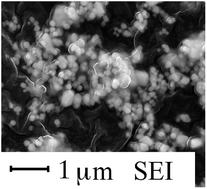Lead sulfate nano- and microparticles in the acid plant blow-down generated at the sulfuric acid plant of the El Teniente mine, Chile†
Abstract
The acid plant ‘blow-down’ (also called weak acid) produced at El Teniente mine in Chile was characterized. This liquid waste (tailing) is generated during the cooling and cleaning of the smelter gas prior to the production of sulfuric acid. The weak acid was composed of a liquid and a solid phase (suspended solids). The liquid phase of the sample analyzed in this study mainly contained Cu (562 mg L−1), SO42− (32 800 mg L−1), Ca (1449 mg L−1), Fe (185 mg L−1), As (6 mg L−1), K (467 mg L−1) and Al (113 mg L−1). Additionally, the sample had a pH-value and total acidity of 0.45 and 2970 mg L−1 as CaCO3, respectively. Hence, this waste was classified as extremely acidic and with a high metal content following the Ficklin diagram classification. Elemental analysis using atomic absorption, inductively coupled plasma, X-ray diffraction and electron microscopy showed that the suspended solids were anglesite (PbSO4) nano- and microparticles ranging from 50 nm to 500 nm in diameter.


 Please wait while we load your content...
Please wait while we load your content...